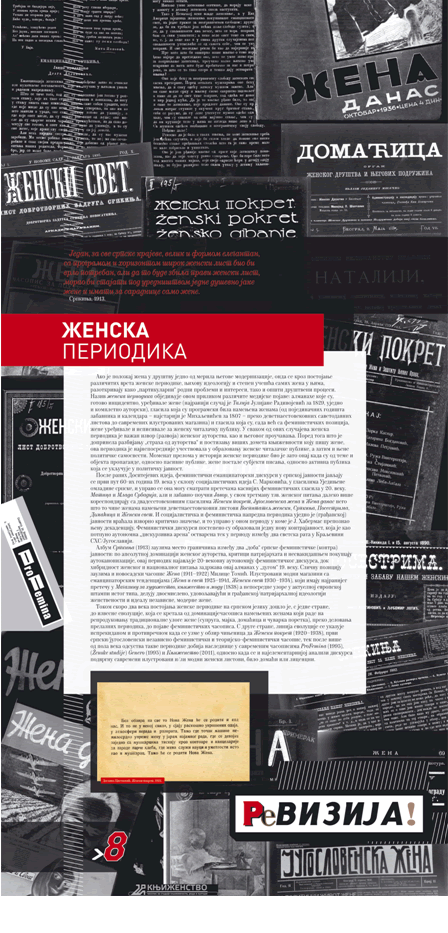By showing the agency dynamics of these periodicals between the 18th and the 21st century, as well as the results obtained through their fertile interdisciplinary research, the authors of the exhibition – Vesna Matović, Biljana Andonovska, Stanislava Barać, Dragana Grbić and Milan Miljković – intended to gain the attention of the new generations and the general public.
The term "women's periodicals" encompasses various types of printed media: the almanacs, which were, rather incidentally, edited by women /the earliest specimen was Talija (1829), by Julijana Radivojević/; several magazines intended for women and various periodicals which were written and edited by female authors, and intended for female readership. Besides their contribution to disruption of "the anxiety of authorship", and to enabling women writers to reach higher literary domains, these periodicals also had the most direct impact on the education of women and on the development of their political self-awareness.
After the early ideas of Dositej Obradović, the first feminist emancipatory discourses began emerging in the Serbia during the 1860s, as a part of the socialist ideas developed by Svetozar Marković. They were circulated in the papers issued by the United Serbian Youth, which are therefore considered to be the predecessors of the 20th century feminist journals. Regarding the treatment of the so called "women issue", the periodicals Matica and Mlada Srbadija, as well as the humorous and didactic Javor, are far more correspondent to the 20th century periodicals, such as the Ženski pokret, Jugoslovenska žena and Žena danas, than the 19th century periodicals, which were specifically women-oriented (Vospitatelj ženski, Srpkinja, Posestrima, Domaćica and Ženski svet). Thus, the feminist discourses gradually started forming a new kind of counter-public, which became fully acknowledged as a completely autonomous "discursive arena" during the period between the two wars, in the Kingdom of Serbs, Croats, and Slovenes, later – Yugoslavia.
The album Srpkinja (1913) is placed at the boundary between the two "ages" of the Serbian feminist (counter) public; absolute dominance of its female authorship, its criticism of the patriarchal society, and its extraordinary efforts to achieve auto-canonization heralded the 20th century autonomy of the feminist discourse, whereas the hybridity of the women and the national issues kept this almanac in the "long" 19th century. Similar position was held by Milica Tomić's magazine Žena (1911–1922) which was printed in Novi Sad. Suchlike illustrated fashion magazines, with the emancipatory tendencies (Žena i svet 1925–1941, Ženski svet 1930–1934), which had Magazin za hudožestvo, knjižestvo i modu (1838) as their earliest predecessor, and the contemporary European magazines as the immediate role-models, seem ambiguous because of their intention to satisfy both the middle class/patriarchal notion of femininity and the ideal of an independent modern woman.
Since women's periodicals held the position on the margins of political and other interests of those in power, they were less affected by official censorship. Instead, the editors themselves developed an "auto-censorship", clearly indicating the orientation of the magazine, as well as the level of freedom and gender awareness.
On the one hand, almost two centuries long existence of women's periodicals in the Serbian language has brought about a certain kind of evolution – starting from the women's magazines aiming to reproduce the traditional roles of women (those of a wife, a mother, a homemaker, and the guardian of the patriarchal order), over the influence of the transitional periodicals, up to the emergence of the feminist magazines. On the other hand, this evolutionary line becomes disrupted, and even contradictory, if we consider the fact that it took more than a half of century for a magazine such as Ženski pokret (Women's Movement) (1920–1938), the first Serbian/Yugoslavian independent theoretical-feminist journal, to gain its successors in the form of today's contemporary journals like ProFemina (1995), (Ženske studije) Genero (1995) and Knjiženstvo (2011).
Prevela Sofija Nemet

